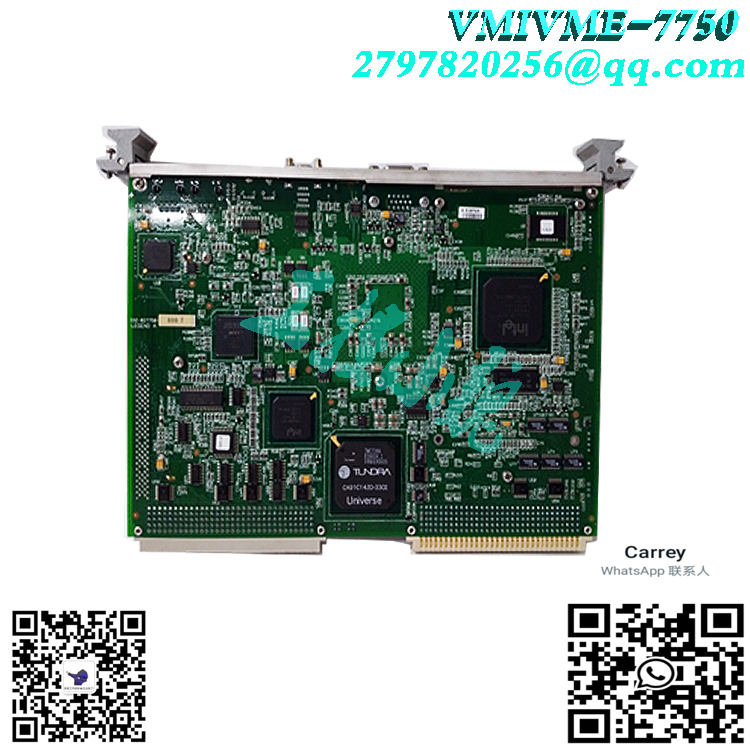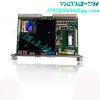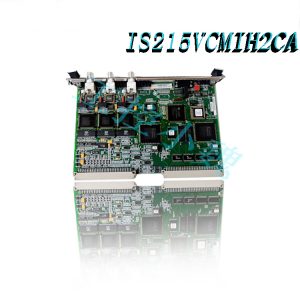Description
Many products have not been listed yet. For more products, please contact us
If the product model is inconsistent with the displayed image, the model shall prevail. Please contact us for specific product images, and we will arrange for photos to be taken and confirmed in the warehouse
We have 16 shared warehouses worldwide, so sometimes it may take several hours to accurately return to you. We apologize for any inconvenience caused. Of course, we will respond to your concerns as soon as possible.
VMIVME-7750-734001 350-027750-734001 K Other names:
Controller module VMIVME-7750-734001 350-027750-734001 K
VMIVME-7750-734001 350-027750-734001 K I/O Module
Single board computer VMIVME-7750-734001 350-027750-734001 K
VMIVME-7750-734001 350-027750-734001 K processor
VMIVME-7750 Intel® Pentium® III Processor-Based VME Single Board Computer
• Comprehensive diagnostics
• Optional disabling of local boots
• Dual-boot option lets users select network or local booting Serial
Ports: Two 16550-compatible serial ports are featured on the VMIVME-7750 front panel.
The serial channel has a 16-b FIFO to support baud rates up to 115 Kbaud. Requires two micro-DB-9 to yte standard DB-9 adapters, GE Fanuc P/N 360- ined oard and mouse connector. A Y-adapter cable is E n option to allow the n I/O space, and are completely e a nonmaskable interrupt (NMI) erved when e O connection to tion d configuration gh performance PCI-to-VME interface from ller. rogrammed to provide the arbitration: GL) Priority (PRI) 010050-001. Keyboard and Mouse Ports: The VMIVME-7750 has a comb PS/2 keyb included.
Flash Memory: The VMIVME-7750 provides up to 1 Gbyte of IDE CompactFlash memory accessible through the secondary ID port. The VMIVME-7750 BIOS includes a board to boot from the Flash memory.
Timers: The VMIVME-7750 provides the user with two 16-bit timers and two 32-bit timers (in addition to system timers).
These timers are mapped i software programmable.
Watchdog Timer: The VMIVME-7750 provides a softwareprogrammable watchdog timer. The watchdog timer is enabled under software control. Once the watchdog timer is enabled, software must access the timer within the specified timer period or a timeout will occur. A user jumper allows the timeout to cause a reset.

PMC Expansion Site: The VMIVME-7750 supports IEEE P1386 common mezzanine card specification with a 5V PCI mezzanin card (PMC) expansion site.
The PMC site provides for standard I/O out the VMEbus front panel. An optional I/ the VMEbus P2 connection can be provided. Contact GE Fanuc Embedded Systems for more informa concerning PMC modules and compatibility.
Universal Serial Bus (USB): The VMIVME-7750 provides a front panel dual connection hub host controller for the USB. Supported USB features include: isochronous data transfers, asynchronous messaging, self-identification an of peripherals, and dynamic (hot) attachment.
VMEbus Interface: The VMIVME-7750 VMEbus interface is based on the Universe IIB hi Newbridge/Tundra.
System Controller: The VMEbus system controller capabilities allow the board to operate as a slot 1 controller, or it may be disabled when another board is acting as the system contro The system controller may be p following modes of Round Robin (RRS) Single Level (S The system controller provides a SYSCLK driver, IACK* daisychain driver, and a VMEbus access timeout timer.
The system controller also provides an arbitration timeout if BBSY* is not seen within a specified period after a BGOUT* signal is issued.

VMEbus Requester: The microprocessor can request and gain control of the bus using any of the VMEbus request lines (BR3* to BR0*) under software control. The requester can be programmed to operate in any of the following modes: Release-On-Request (ROR) Release-When-Done (RWD) VMEbus Capture and Hold (BCAP)
Mailboxes: The VMEbus interface provides four 32-bit mailboxes, which are accessible from both the microprocessor and the VMEbus providing interprocessor communication. The mailboxes have the ability to interrupt the microprocessor when accessed by VMEbus.
Interrupt Handler: The interrupt handler monitors, and can be programmed to respond to any or all VMEbus IRQ* lines. All normal-process VMEbus-related interrupts can be mapped to PCI INTA# or SERR# interrupts. These include: Mailbox interrupts VMEbus interrupts VMEbus interrupter IACK cycle (acknowledgment of VMIVME-7750 VMEbus-issued interrupts) All error processing VMEbus-related interrupts can be mapped to PCI INTA# or SERR#.
Note: PCI SERR# initiates a SBC NMI. These include: ACFAIL* interrupt BERR* interrupt SYSFAIL* interrupt The interrupt handler has a corresponding STATUS/ID register for each IRQ* interrupt. Once the handler receives an IRQ*, it requests the VMEbus and, once granted, it performs an IACK cycle for that level. Once the IACK cycle is complete and the STATUS/ID is stored in the corresponding ID register, an appropriate interrupt status bit is set in an internal status register, and a PCI interrupt is generated.The PCI interrupt can be mapped to PCI INTA# or SERR#.
Interrupter: Interrupts can be issued under software control on any or all of the seven VMEbus interrupt lines (IRQ7* to IRQ1*). A common ID register is associated with all interrupt lines. During the interrupt acknowledge cycle, the interrupter issues the ID to the interrupt handler.
The interrupter can be programmed to generate a PCI INTA# or SERR# interrupt when a VMEbus interrupt handler acknowledges a software-generated VMEbus interrupt.
Byte Swapping: The Intel 80×86 family of processors use littleendian format. To accommodate other VMEbus modules that transfer data in big-endian format such as the 680×0 processor family, the VMIVME-7750 incorporates byte-swapping hardware.
This provides independent byte swapping for both the master and slave interfaces. Both master and slave interface byte swapping are under software control. VMIVME-7750 Intel® Pentium® III Processor-Based VME Single Board Computer The VMIVME-7750 supports high throughput DMA transfers of bytes, words, and longwords in both master and slave configurations. If endian conversion is not needed, we offer a special “bypass” mode that can be used to further enhance throughput. (Not available for byte transfers.)
Master Interface: MA32:MBLT32:MBLT64 (A32:A24:A16:D32:D16:D8 (EO):BLT32) The VMEbus master interface provides nine separate memory windows into VMEbus resources. Each window has separate configuration registers for mapping PCI transfers to the VMEbus (that is, PCI base address, window size, VMEbus base address, VMEbus access type, VMEbus address/data size, etc.).
The maximum/minimum window sizes for the nine windows are as follows: Window Minimum Size Maximum Size 0, 4 4 Kbyte 4 Gbyte 1 to 3, 5 to 7 64 Kbyte 4 Gbyte Special Cycle 64 Mbyte 64 Mbyte Slave Interface: Memory Access SAD032:SD32:SBLT32:SBLT64 (A32:A24:A16:D32:D16:D8 (EO): BLT32) The VMEbus slave interface provides eight separate memory windows into PCI resources. Each window has separate configuration registers for mapping VMEbus transfers to the PCI bus (that is, VMEbus base address, window size, PCI base address, VMEbus access type, VMEbus address/data size, etc.).
The maximum/minimum window sizes for the eight windows are as follows: Window Minimum Size Maximum Size 0, 4 4 Kbyte 4 Gbyte 1 to 3, 5 to 7 64 Kbyte 4 Gbyte In addition, each window can be programmed to operate in coupled or decoupled mode. In decoupled mode, the window utilizes a write-posting FIFO and/or a read prefetching FIFO for increased system performance. In coupled mode, the FIFOs are bypassed and VMEbus transactions are directly coupled to the PCI bus (that is, transfers on VMEbus are not completed until they are completed on the PCI bus).
Enhanced Bus Error Handling: Enhancements over the Universe chip’s bus error handling features are provided. A latch and register are provided to allow the SBC to read the VMEbus address that caused the bus error in all modes. The Universe chip’s support is limited to decoupled mode. Support for bus cycle timeout and assertion of bus error is provided.
The board may be configured to assert bus error upon timeout regardless of its status as system controller. The Universe chip asserts bus error only if it is system controller. In addition, this board may be configured to assert an interrupt upon bus cycle timeout. Operating System and Software Support The VMIVME-7750 provides embedded features beyond PC/AT functionality.
These features are supported by GE Fanuc Embedded Systems software products aimed at developers who are incorporating GE Fanuc Embedded Systems SBCs, I/O boards, and workstations into systems. Windows XP/Windows 2000 and VxWorks are the most common operating systems supported by GE Fanuc Embedded Systems software products.
Windows XP/Windows 2000: The IOWorks® software family is a set of software components that can work together or separately to provide a total development environment for any application in a Windows XP/ Windows 2000 OS.
VMISFT-9422 VMEbus Access™ for Windows XP/Windows 2000: The VMEbus Access product is specifically designed for accessing the advanced VMEbus Access architecture of the VMIVME-7750.
Running on Windows XP/Windows 2000, VMEbus Access is both sophisticated and easy to use. The function library, VMEbus toolset and open architecture VMEbus Access offers make it one of the most powerful products on the market today. It provides compatibility with existing GE Fanuc Embedded Systems VME PC platforms and compatibility within the future VME PC platforms GE Fanuc Embedded Systems creates. The VMEbus Access development package gives you everything you need to develop applications for your VME operations.
This package includes the VMEmanager™ function library and four utilities that enable you to easily configure a VMEbus, dynamically monitor VMEbus activities, manage VMEbus data, and use DDE-client applications. VMEbus Access provides powerful tools for developing, debugging and monitoring VMEbus applications and increasing VMEbus performance.

For example, VMEbus Access enables your VMEbus to recognize applications developed in these popular programming environments:
• IOWorks Manager™
• LabVIEW
• Citect
• Wonderware InTouch
• Visual IOWorks®
• Visual Basic® Visual C++® d
• VxWorks OS Support — VMISFT-7418 Board Support Package:
The VMISFT-7418 is a Wind River Systems, Inc.’s certified board support package (BSP) for GE Fanuc Embedded Systems’ series of VME Pentium processor-based computers, which is require to run the VxWorks OS. With the SBC, VxWorks, the BSP, and 4
VMIVME-7750 Intel® Pentium® III Processor-Based VME Single Board Computer other VME equipment from GE Fanuc Embedded Syste implementations can be created for a wide variety of applications, including real time factory automation, sim instrumentat ms, ulation, ion and control, and process control and ware nuc rts, ards.
The e as . ture g-endian and little-endian devices to us g r 7xxx SBC boards without requiring any ge: ilitary aris OS provides POSIXivers s ent based on industry-wide rted I/O board and new uc ; or ications 6U .3mm) m 2 and -12VDC are specified with the operating temperature is available for the following C) measured at outside of heatsink is to be %, noncondensing rfa (3 to 0), ROR,
RWD, BCAP dle r: IRQ7* to IRQ1* r: le (4 to 1,024 µs) signaling, types 1 and 2 TBF: 118,633 hours (Bellcore) monitoring. The BSP is linked with VxWorks OS, thus allowing soft applications created with Wind River Systems, Inc.’s development system to load and run on the particular GE Fa Embedded Systems SBC hardware being used. Serial po parallel ports, keyboard, text mode video, and Ethernet transceivers are all supported, as well as floppy and IDE hard disk drives that can be connected to the computer bo BSP provides Flash boot, NVRAM and timer support.
The BSP allows VxWorks applications to have access to th VMEbus. When hardware includes single cycle and block transfers using DMA devices, they are supported by the BSP, are interprocessor communications with mailbox registers. VMEbus interrupt handling and error handling are supported Since the VMEbus environment often contains a mixture of devices from various manufacturers, the byte-swapping fea is provided to allow bi share data correctly.
QNX OS Support — VMISFT-7417 Board Support Package: VMISFT-7417 BSP provides QNX support and includes a VMEb manager, user API and configuration files needed to run the QNX BSP on GE Fanuc Embedded Systems’ VMIVME-7xxx SBC products.
This BSP provides customizable VMEbus access. Usin the QNX OS on the VMIVME-7xxx SBCs provides a computing platform suitable for real time applications. QNX provides the applications programmer with a real time extensible POSIX OS. GE Fanuc Embedded Systems’ VMISFT-7417 is designed to tailo QNX’s x86 OS to the VMIVME-7xxx platform.
This combination provides a self-hosted development environment which runs entirely on the VMIVMEexternal host systems. Solaris OS Support — VMISFT-7416 Board Support Packa VMISFT-7416 BSP includes everything necessary to allow installation of the Solaris Intel edition OS (available separately from Sun Microsystems, Inc.) onto the VMIVME-7750 SBC. This BSP includes a nexus driver for VMEbus access. It allows m and telecommunications and other applications to take advantage of Sun Microsystems, Inc.’s Solaris OS on a VMEbased Intel SBC.
This BSP and the Sol compliant real time characteristics. LynxOS x86 OS Support — VMISFT-7419 Board Support Package: The VMISFT-7419 BSP includes all of the device dr and configuration tables needed to install the LynxOS x86 development system (available separately from Lynx Real-Time Systems, Inc.) onto GE Fanuc Embedded Systems VMIVME-7750.
Using the LynxOS on the GE Fanuc Embedded Systems SBC provides a computing platform suitable for hard real time applications. LynxOS provides the applications programmer with a stable development environm standards such as POSIX and Motif.
I/O Support — VMISFT-9450 IOWorks Board Drivers: This driver supports GE Fanuc Embedded Systems’ extensive line of VME I/O boards and is available for Windows XP/Windows 2000 and VxWorks. IOWorks board drivers take advantage of all the key benefits and features of each suppo I/O boards are constantly being added.
IOWorks board drivers contain both a C++ class library and a C function library that provide a common interface to GE Fan Embedded Systems I/O products for reading, writing and configuring. You do not need to know the details of how an individual board is programmed. For instance, you can use the SetAttributes function on any supported GE Fanuc Embedded Systems board; the WriteAnalog function controls the output from any GE Fanuc Embedded Systems analog output board the GetScanMode function retrieves the scan mode for any GE Fanuc Embedded Systems analog board. Physical/Environmental Specif Dimensions: single slot Eurocard format Height 9.2 in. (233.4mm) Depth 6.3 in. (160mm) Thickness 0.8 in.
(20 Power Requirements: +5VDC (±5 percent), 6A (typical), 7A maximum +12VDC (±5 percent), 105mA (typical), 200mA maximu -12VDC (±5 percent), 50mA (typical),
75mA maximum Note: The currents at +1 serial connectors open. Operating Temperature: 0 to 50° C Extended options: A=2 (733 MHz, 0 to 60° C) A=9 (1.26 GHz, 0 to 55° A=6 (1 GHz, 0 to 40° C) (Air flow requirement as greater than 350 LFM)
Storage Temperature: -25 to 80° C Relative Humidity: 10% to 90
VMEbus Inte ce: DTB Master: BLT32/BLT64, A32/D32, A24/D32, A16/D32 DTB
Slave: BLT32/BLT64, A32/D32, A24/D32, A16/D32
Requester: Programmable, BR Interrupt Han r: IH(1 to 7) D8(O) Interrupte Programmable Arbite SGL, PRI,
RRS BTO: Programmab Compliance: Rev. C.1 PMC Expansion Site Connector: 5V 32-bit PCI bus, 33 MHz maximum
All products on this website are special products, and market prices have been fluctuating,
The specific customer service quotation shall prevail, as the product is a new product and the price is not genuine,
Please confirm the model, product, price, and other detailed information with customer service before placing an order. The website has been used,
The new one is for sale, please contact customer service to communicate.
Model recommendation:
VMIVME-7614-132
VMIVME-7740-850
VMIVME-7740-850 350-007740-850 L
IC698RMX016-ED VMIVME-5567-100
VMIVME-5567-100
VMIVME-5530S
VMIVME-7645
VMIVME-7696-650
VMIVME-7658-330
VMIVME2170A 333-102170-000
VMIVME-2533-000 32
VMIVME-4140-000
VMIVME-5565-010000
VMIVME-5565-110000
VMIVME-7750-734001
VMIVME-7750-734001
VMIVME-7750
VMIVME-7614-132
VMIVME-7740-850
VMIVME-7740-850
More……










-300x300.jpg)
-300x300.jpg)
admin –
VMIVME-7750 provides a software programmable watchdog timer. The watchdog timer is enabled under software control. Once the watchdog timer is enabled, the software must access the timer within the specified timer cycle, otherwise a timeout will occur. User jumper allows timeout, resulting in reset. Independent of the jumper, the software can cause VMEbus SYSFAIL due to watchdog timeout.
angel –
The GE VMIVME-7750 CPU module plays a very important role in automation system control. Implementation and application of a substation automation testing simulation system based on PLC modules. The GE VMIVME-7750 CPU is a processor based VME (VMEbus) single board computer designed specifically for high-performance applications that require real-time control and monitoring. It revolves around Intel ®; Pentium ®; Built with a III processor, it provides processing power up to 1.26 GHz and advanced transfer caching of 512 Kbytes. The system uses a single SODIMM to support up to 512 megabytes of PC133 SDRAM and has an internal AGP SVGA controller with 4 megabytes of display cache. It passes through Intel ® The 815E chipset controller runs on a 133 MHz system bus and supports 10BaseT and 100BaseTX Ethernet interfaces, as well as dual Ethernet interfaces for networking.
VMIVME-7750 supports a range of operating systems, including Windows ® XP, VxWorks ®、 Solar ™、 QNX ®、 LynxOS ® And Linux ®, Provides flexibility for various applications such as real-time factory automation, simulation, instrumentation, control, and process control systems. It also includes comprehensive diagnosis, optional local boot disable, and dual boot options for selecting network or local boot.